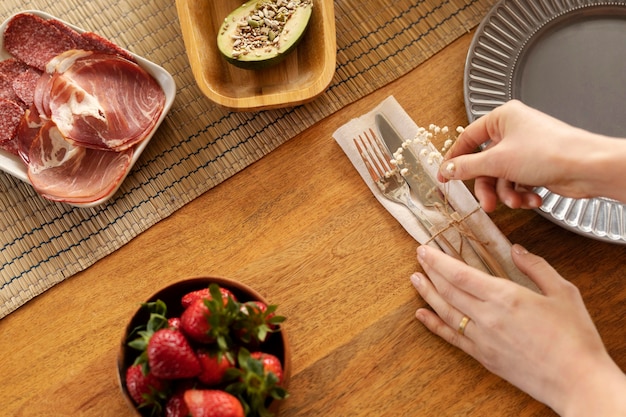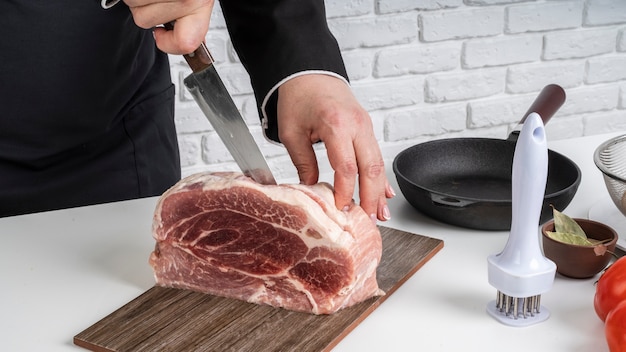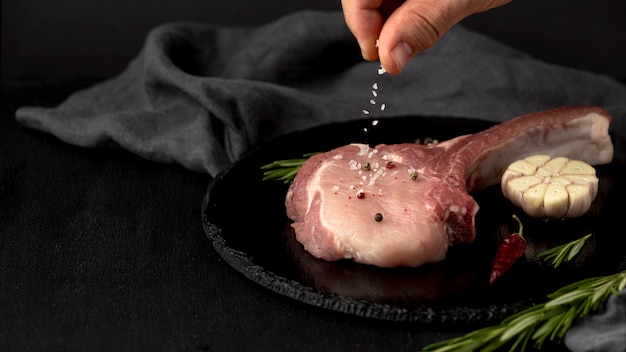(Part 1) choosing the right cut: A Butcher's Tale

Unveiling the Secrets: What to Look For
When you're facing a wall of beef, it's easy to feel overwhelmed. But I've got you covered. Here's a breakdown of what to look for in a good chuck tenderloin:- Marbling: The Flavour Secret: Think of marbling as the hidden gem of a chuck tenderloin. It's the fat that runs through the meat, adding that incredible flavour and keeping it juicy. The more marbling, the better! Imagine it as nature's secret ingredient. You want to see a good balance of lean meat and those little streaks of white fat.
- Colour: A Sign of Freshness: Look for a rich, deep red colour. It should be bright and even, free from any odd patches or dullness. Think of it like a vibrant ruby. That's a sign of freshness, my friend. And freshness is key!
- Texture: The Feel of Quality: The meat should feel firm and springy, not soft or mushy. It's like a good handshake, you know? It should feel solid and reassuring. If it's too soft, it might be a sign it hasn't been handled properly.
- Thickness: Perfect for Even Cooking: Aim for a steak that's about 1 inch thick. That way, you've got enough meat for a nice sear on the outside and a juicy, tender center.
Freshness is Queen: A Culinary Golden Rule
I've always believed that freshness is crucial for any meat, but especially for a chuck tenderloin. It's a little more delicate than some of the other cuts. You want to make sure it's been stored and handled with care so you don't end up with a dry, tough steak. Don't be afraid to ask the butcher about their storage practices. They're the experts, and they'll be happy to assure you about the quality of their meat.My Secret Weapon: Dry-Aged Beef
Okay, I have a little confession. I've got a real soft spot for dry-aged beef. It's like the gourmet version of chuck tenderloin, a little more complex and indulgent. The ageing process develops a richer flavour and a more tender texture. It's almost like the meat has been basking in a flavour bath for a few weeks. It's worth seeking out a butcher who specializes in dry-aged beef. They'll be able to guide you through the process and help you find the perfect cut for your needs.(Part 2) Preparing the Steak: Setting the Stage

Pat it Dry: The Key to a Great Sear
First things first, pat the steak dry with a paper towel. You want to make sure that surface is nice and dry, so the heat can penetrate the meat properly. Imagine it as a canvas ready for a masterpiece. A dry surface ensures you get that gorgeous, crispy sear that's so crucial for a good chuck tenderloin steak.Let it Breathe: Room Temperature is Key
After that, let the steak sit out at room temperature for about 30 minutes before you cook it. This gives the meat a chance to come up to temperature and ensures even cooking. It's like giving it a little warm-up before a big workout. It really does make a difference! It helps the meat cook more evenly and prevent any cold spots.Oil is the Enemy: Trust in the Fat
This is a big one, folks. Don't use oil when you're searing a steak. It might seem counterintuitive, but oil can actually prevent you from getting a nice sear. The fat in the meat will melt and create that beautiful, flavorful crust all on its own. It's all about letting the steak do its thing. You'll be amazed by how the natural fats create a delicious crust that's both crispy and flavorful.(Part 3) Cooking Methods: Finding Your Style

1. Pan-Seared: Classic and Comforting
This is the go-to method for a reason. It's easy, reliable, and delivers a perfectly cooked steak every time. It's perfect for smaller cuts of meat that can be easily managed in a pan. Here's how I do it:Get a heavy-bottomed pan nice and hot over medium-high heat. You want it screaming hot! Add a knob of butter to the pan, and when it's melted and sizzling, gently place the steak in the pan. It’s best not to overcrowd the pan; you want each steak to have its own space to cook properly.
Now, the magic happens. Cook the steak for about 2-3 minutes per side, or until a delicious, crusty exterior forms. That's what we're after! It's like a little golden shield, protecting the juicy goodness within.
Now, reduce the heat to medium-low and cook for another 3-4 minutes per side, or until the steak reaches your desired level of doneness. If you're unsure, grab your trusty meat thermometer (more on that later!). Remember, the key is to avoid overcooking. You want a tender, juicy steak, not a dry, tough one.
Once the steak is cooked to your liking, remove it from the pan and place it on a cutting board. Cover it loosely with aluminum foil to let it rest for 5-10 minutes. This allows the juices to redistribute, making for a supremely tender and juicy steak. And don't forget to season it with a little bit of butter, salt, and pepper. Simple, but oh so delicious!
2. Grilled: Summertime Perfection
What's a summer cookout without a good grilled steak? It's the quintessential summertime treat. But make sure you've got a good quality grill that can get really hot. You want those grill marks!Preheat your grill to medium-high heat. You want it nice and hot, ready to sear those delicious grill marks. When the grill is ready, carefully place the steak on the grates. Cook for about 2-3 minutes per side, or until that nice crust forms.
Now, here's a little trick. Rotate the steak 90 degrees and cook for another minute or two to get those perfect, crosshatch grill marks. It’s like adding a little bit of art to your cooking.
Reduce the heat to medium-low and continue cooking for another 3-4 minutes per side, or until your steak reaches your desired level of doneness. Use your trusty meat thermometer to make sure you get it just right.
Once the steak is done, remove it from the grill and let it rest for 5-10 minutes before slicing and serving. And don’t forget those grill marks. They’re the best part!
3. Slow-Cooked: A Tender and Flavorful Feast
If you're looking for a tender and flavorful steak, slow cooking is your answer. It's like giving the chuck tenderloin a long, relaxing spa treatment. The slow heat breaks down the muscle fibres, resulting in a melt-in-your-mouth texture. It's perfect for a busy weeknight, because you can just set it and forget it while you get on with your day.Place the steak in your slow cooker. Season it liberally with your favourite spices; don’t be shy! Remember, the slow cooker allows the flavors to really meld. Add a bit of liquid like beef broth or water to help keep the steak moist.
Cook on low for 6-8 hours, or on high for 3-4 hours, or until the steak is cooked to your liking. Use your meat thermometer to make sure you don’t overcook it.
Once the steak is done, remove it from the slow cooker and let it rest for a few minutes before slicing and serving. A slow-cooked chuck tenderloin steak is perfect for sandwiches or salads. It's so tender it just melts in your mouth!
(Part 4) Doneness Levels: Finding Your Sweet Spot
Knowing how to cook your steak to the perfect level of doneness is like finding the key that unlocks a world of flavor. It's all about striking that perfect balance between a juicy interior and a crispy exterior. Let's dive into the most popular doneness levels:1. Rare: A Touch of Red
A rare steak will have a cool red center. It's best cooked over high heat for a short time, just a quick kiss of heat. Think of it as the most minimalist approach to steak cooking. The center will be red and soft, with a slightly warm temperature.2. Medium-Rare: Pink Perfection
A medium-rare steak has a warm red center with a slightly pink edge. It's cooked a bit longer than a rare steak, but it still retains that juicy interior. It’s the happy medium for many steak lovers!3. Medium: The Classic Choice
A medium steak has a warm pink center with a light brown edge. It's cooked even longer than a medium-rare steak and is starting to lose that deep red hue. It's a popular choice for steak lovers who like a bit more cooked through.4. Medium-Well: Between Doneness Levels
A medium-well steak has a warm brown center with a light brown edge. It's cooked longer than a medium steak and is losing most of its pink color. The center will be mostly brown, with a touch of pink.5. Well-Done: Cooked Through and Through
A well-done steak is cooked through and through. It has a brown center and a crispy, brown exterior. It's the most cooked level of doneness. It's not for everyone, but some folks prefer it!The Meat Thermometer: Your Cooking Companion
To make sure you get your steak cooked to your exact specifications, a meat thermometer is your best friend. It's like having a little detective in your kitchen, uncovering the secrets of your steak's internal temperature. You can find a meat thermometer at most grocery stores and online. It's a small investment that will make a big difference in your cooking.(Part 5) Resting the Steak: A Moment of Calm
After all that heat and excitement, it's important to give your steak a moment to cool down and relax. Think of it as a little post-workout stretch for your steak. It helps it redistribute its juices and ensures a juicy, tender result.The Science of Resting: Why It's Crucial
As the steak cooks, the juices get pushed towards the surface. If you cut into the steak immediately after cooking, those juices will run out, leaving you with a dry, disappointing steak. But by letting it rest, those juices are reabsorbed back into the steak, resulting in a tender, flavorful masterpiece.How to Rest: Simple and Effective
Resting your steak is a simple process. Transfer the steak to a cutting board and cover it loosely with aluminum foil. This traps the heat and helps the juices redistribute. Let it rest for 5-10 minutes before slicing and serving. It's a small step, but it makes a big difference in the final product!(Part 6) Slicing and Serving: The Grand Finale
The steak is cooked, rested, and ready to shine. It's time to slice it up and get ready to enjoy.Slicing Against the Grain: Unlocking Tenderness
To ensure that you get nice, even slices, cut the steak against the grain. This means cutting perpendicular to the muscle fibers. If you slice with the grain, the steak will be tougher and chewier. Think of the pattern of the lines on the steak; you're cutting across those lines.Serving Up Flavor: A Feast for the Senses
A beef chuck tenderloin steak is incredibly versatile. It pairs perfectly with many different sides. I love serving it with roasted vegetables, creamy mashed potatoes, or a simple green salad. And don’t forget about the sauce! A classic béarnaise sauce is always a crowd-pleaser. A good chimichurri sauce is another great option, especially if you're looking for something lighter and more flavorful.(Part 7) Leftovers: Making the Most of Your MealSometimes, you might have leftover steak. It happens to the best of us. But don’t despair! Leftover steak is a culinary treasure waiting to be reinvented. Storing Leftovers: Keeping the Flavor Fresh
To store leftover steak, simply wrap it tightly in plastic wrap or aluminum foil. You can store it in the refrigerator for up to 3-4 days. It's best to avoid leaving it at room temperature for too long. Reheating Leftovers: Second Chance Deliciousness
When you're ready to enjoy your leftover steak, you can reheat it in a pan over medium heat or in the oven at 350 degrees F. Just be careful not to overcook it. You want it to be heated through, but not dry. If you're reheating in the oven, wrap the steak in foil to help keep it moist.(Part 8) Tips and Tricks: Mastering the Art
Here are a few extra tips and tricks to help you elevate your chuck tenderloin game:- Don't Overcrowd the Pan: When you're pan-searing, give each steak enough space to cook evenly. If the pan is too crowded, the steak will steam instead of sear, and you'll miss out on that perfect crust.
- Use a Meat Thermometer: I can't stress this enough. A meat thermometer is essential for making sure your steak is cooked to your liking. It's a game-changer for getting that perfect doneness.
- Let the Steak Rest: Always let your steak rest for 5-10 minutes before slicing and serving. This allows the juices to redistribute, resulting in a tender, juicy steak.
- Don't Overcook: Overcooked steak is a culinary crime! Use a meat thermometer to ensure your steak is cooked to your desired level of doneness, and avoid overcooking.
- Experiment with Seasonings: Don't be afraid to get creative with your seasonings! There are endless possibilities.
- Try Different Cooking Methods: Explore different cooking methods, like grilling, slow-cooking, or even smoking. You might discover a new favourite way to cook your beef chuck tenderloin.
(Part 9) FAQs: The Answers You Need
Let's tackle some of the most common questions about cooking beef chuck tenderloin steak:1. Is Beef Chuck Tenderloin Steak Tough?
Beef chuck tenderloin steak can be tough if it's not cooked properly. However, with the right cooking method and some patience, you can make it incredibly tender and juicy. It's all about understanding the meat and treating it with the respect it deserves.
2. What's the Best Way to Cook Beef Chuck Tenderloin Steak?
There is no one "best" way to cook a beef chuck tenderloin steak. It depends on your personal preferences and what you're looking for in terms of flavor and texture. Some people prefer pan-searing, while others like to grill or slow-cook their steaks. Experiment and find your own personal favorite!
3. How Long Should I Cook a Beef Chuck Tenderloin Steak?
The cooking time for a beef chuck tenderloin steak will vary depending on the thickness of the steak and your desired level of doneness. Use a meat thermometer to ensure that your steak is cooked to your liking.
4. What's the Best Temperature to Cook a Beef Chuck Tenderloin Steak?
The best temperature for cooking a beef chuck tenderloin steak depends on the cooking method you're using. For pan-searing, you'll need a hot pan, while for grilling, you'll want a medium-high heat. For slow-cooking, you'll need a lower temperature. Refer to the specific cooking instructions for the method you choose.
5. What Should I Serve with Beef Chuck Tenderloin Steak?
Beef chuck tenderloin steak pairs well with many different sides. Some popular choices include roasted vegetables, creamy mashed potatoes, green salads, and various sauces. You can also get creative and experiment with different flavors.
(Part 10) Conclusion: Embrace the Journey
There you have it! The secrets to cooking the perfect beef chuck tenderloin steak. It's a simple cut of meat, but with a little care and attention, it can be a real star of the show. Remember, practice makes perfect. Keep experimenting, refining your techniques, and you'll be a chuck tenderloin pro in no time. Enjoy!Everyone is watching

Corn on the Cob: The Ultimate Guide to Perfectly Cooked Ears
Healthy MealsAh, corn on the cob. Just the name evokes images of sunny days, barbecues, and that sweet, juicy flavour that ...

Perfect Pork Roast Oven Cooking Time: A Guide to Delicious Results
Healthy MealsThere's something truly satisfying about a perfectly roasted pork. The aroma alone is enough to make your mout...

Ham Cooking Time: How Long to Bake, Smoke, or Boil a Delicious Ham
Healthy MealsAh, ham. It's a classic, isn't it? A real crowd-pleaser, especially around holidays. And when done right, it'...

Scallops: The Ultimate Guide to Perfect Cooking
Healthy MealsAh, scallops. Those delicate, sweet, and utterly delicious morsels of the sea. They hold a special place in my...

Spaghetti Squash: The Ultimate Guide to Cooking and Serving
Healthy MealsRemember that time you saw spaghetti squash at the supermarket, looking all bumpy and strange, and thought, "W...
